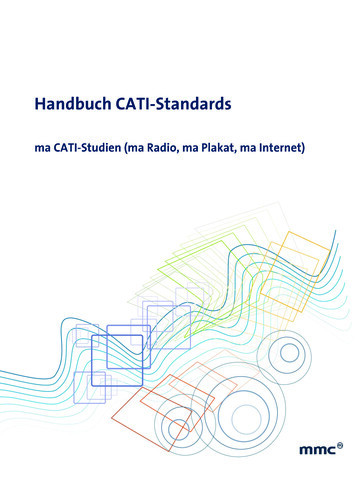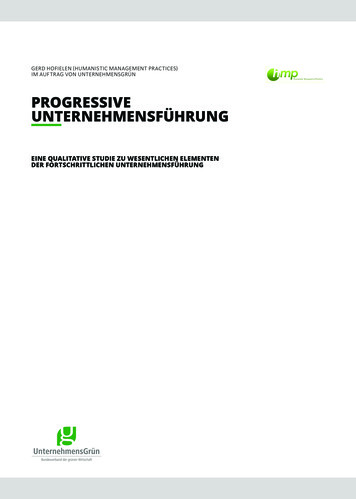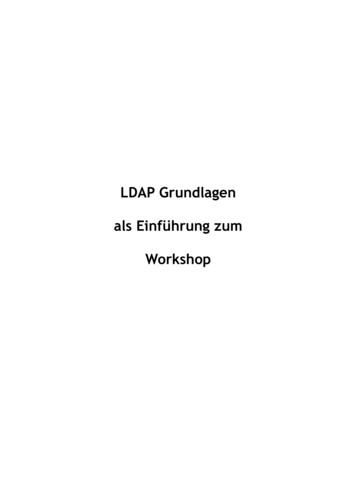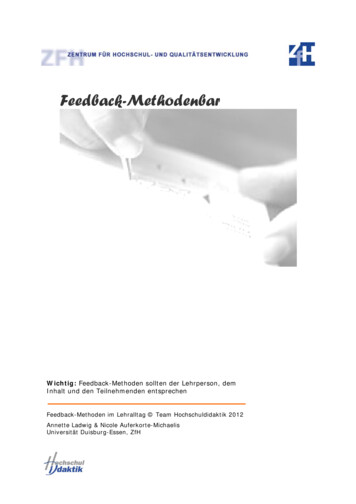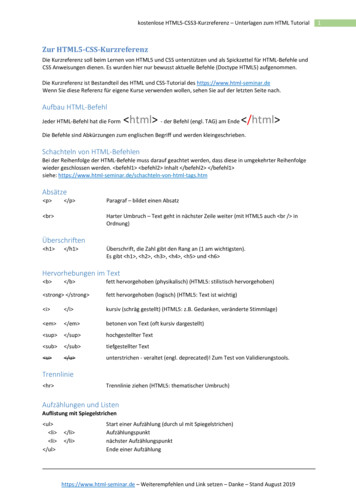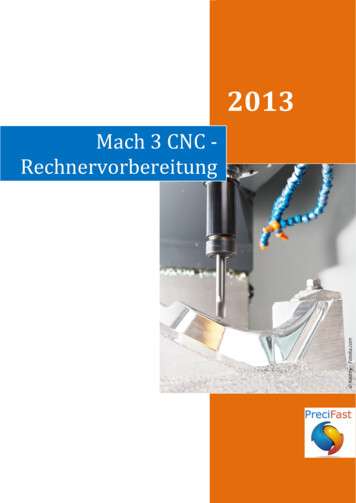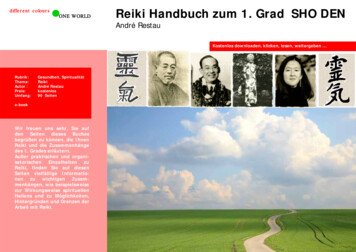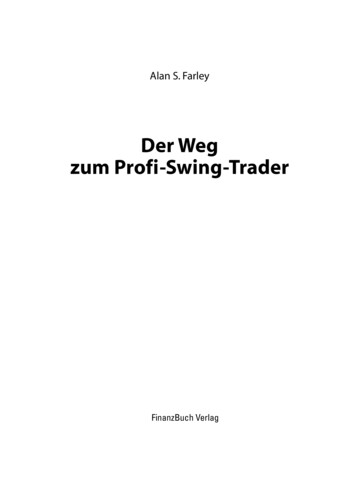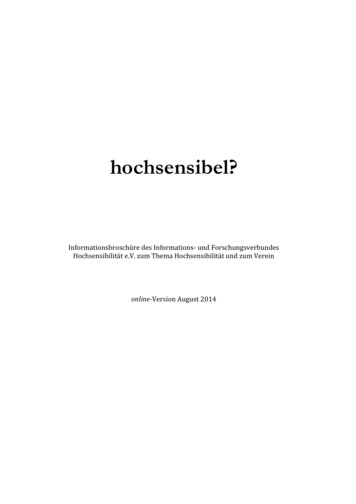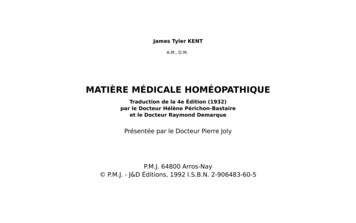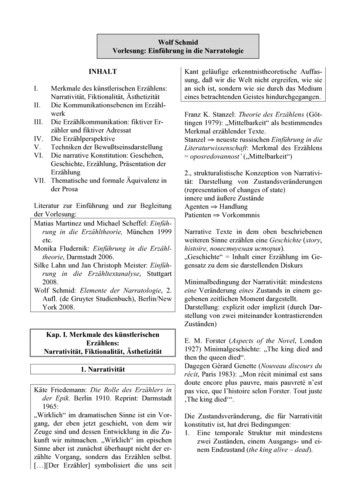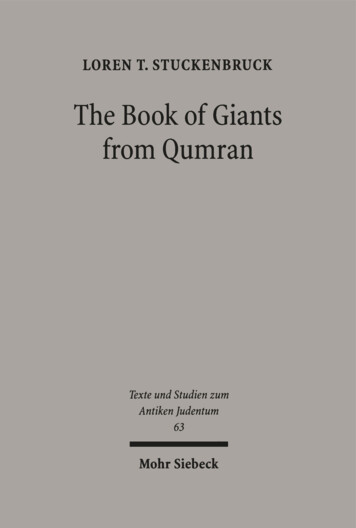
Transcription
Texte und Studien zum Antiken JudentumHerausgegeben vonMartin Hengel und Peter Schäfer63
Loren T. StuckenbruckThe Book of Giantsfrom QumranTexts, Translation, and CommentaryMohr Siebeck
Die Deutsche Bibliothek Stuckenbruck,CIP-EinheitsaufnahmeLoren T.:The book of giants from Qumran : texts, translation, and commentary / Loren T.Stuckenbruck. - Tübingen : Mohr Siebeck, 1997(Texte und Studien zum antiken Judentum ; 63)ISBN 3-16-146720-5978-3-16-158788-7 Unveränderte eBook-Ausgabe 2019 1997 J. C. B. M o h r (Paul Siebeck), P. O. Box 2040, D-72010 Tübingen.This book may not be reproduced, in whole or in part, in any form (beyond that permittedby copyright law) without the publisher's written permission. This applies particularly toreproductions, translations, microfilms and storage and processing in electronic systems.The book was typeset by ScreenArt in Wannweil using Times typeface, printed by GuideDruck in Tübingen on non-aging paper from Papierfabrik Niefern and bound by Heinr.Koch in Tübingen.ISSN 0721-8753
for Otto Betzin honour of his 80th birthday8. June 1997
PrefaceThe Book of Giants has long been known as a work which circulatedamong the Manichaeans as a composition attributed to Mani. Thus thecondemnation of the "Liber de Ogia nomine gigante " as an "apocryphus "in the Decretum Gelasianum (perhaps 6th century) may presuppose a claimrelating to its Manichaean origins. However, a case for its existence priorto Mani was made by the important Huguenot scholar, Isaac de Beausobre in 1734 (vol. 1 of his Histoire critique de Manichèe et du Manicheìsme,p. 429 n. 6, cited by W. B. Henning in "The Book of the Giants", BSOAS11 [1943-1946] p. 52). De Beausobre inferred that Mani must have drawnupon at least two mauvais sources: a "Book of Enoch " and a further writing which the 9th-century chronographer Georgius Syncellus had described as T] ypacpri xcòv yiyavxcov. The latter work was, in turn, said tohave been discovered after the flood by a certain Katvav (Noah's greatgrandson according to LXX Gen. 10:24) who subsequently "hid it awayfor himself" (see Alden A. Mosshammer, Georgii Syncelli Ecloga chronographica [Bibliotheca Scriptorum Graecorum et Romanorum Teubneriana; Leipzig: Teubner Verlagsgesellschaft, 1984] p. 90: eicpmj/e Ttap'èauxcò). Whether or not Syncellus' comment was influenced by Jubilees8:4 (or a later version thereof) at this point, the explicit mention of "TheBook of the Giants" without, at the same time, there being any reference orallusion to Mani or Manichaeism may be significant: it is possible that thenomenclature in Syncellus ultimately has its roots in the existence of anindependent source whose precise content was no longer known to him.During the course of the 20th century a number of finds have shedconsiderable light on the literary evidence for the Book of Giants. Thediscoveries and publications of Manichaean fragments from the Book ofGiants have, of course, substantiated the many references to its circulationamong and use by the Manichaeans. And now, as is well known, the recovery of manuscript fragments from Qumran Caves 1, 2, 4, and 6 haveconfirmed the Book of Giants as an independent Jewish composition fromthe Second Temple period. Whereas the Manichaean materials and possible allusions to the Manichaean Book of Giants have recently been subjected to a timely analysis by John C. Reeves (Jewish Lore and Manichaean
VIIIPrefaceCosmogony. Studies in the Book of Giants Traditions [Monographs of theHebrew Union College 14; Cincinnati: Hebrew Union College Press,1992]), the present volume takes its point of departure in the Book ofGiants as an early Jewish work from the Second Temple period.My interest in the Book of Giants was triggered ten years ago while Iwas engaged in a lexical analysis of the Greek recensions to 1 Enoch (esp.Codex Panopolitanus, Syncellus a b , and the Chester Beatty ms.) and theEnochic Aramaic fragments from Qumran in Tübingen and Heidelberg.Several years later, in the context of a doctoral seminar with ProfessorJames H. Charlesworth at Princeton Theological Seminary, I was able toengage in an initial study of some of the published fragments which J. T.Milik had identified with the Book of Giants (The Books of Enoch [Oxford: Clarendon Press, 1976]). However, the possibility of any publicationat that time was precluded, as analysis was frustrated by the unavailabilityof the pertinent photographic evidence. Of course, this situation changeddramatically with the publication and itemization of the Rockefeller collection (formally PAM) in 1993 by Emanuel Tov, ed., The Dead Sea Scrollson Microfiche (Leiden: E. J. Brill). This provided an opportunity for me at first through the encouragement of Professor Peter Lampe at the University of Kiel - to resurrect a dormant study and to pursue a more thoroughgoing analysis.It is here appropriate to stress that the investigation carried through inthis book should in no way be confused with an 'official' publication ofthose Book of Giants fragments which have yet to appear in the Discoveries in the Judaean Desert series. For one thing, this volume as suchis wider in scope in that it embraces virtually all fragments (unpublishedand published) which have been related to the Book of Giants. Moreover,some features which have accompanied the publication of the Qumranfragments have not been included: most obviously, plates; measurementsof the individual fragments; and, in some cases, a detailed discussion ofpalaeography and orthography (though these considerations are not entirely excluded).It is hoped that the present study has been able to throw further light onthe Book of Giants as an early Jewish document to be taken seriously inits own right. The main body of the volume - i. e. the text, English translation, notes, and commentary of the relevant manuscript fragments fromQumran - is to be found in Chapter Two (pp. 41-224), with Chapter Oneproviding an introduction to the study of the document along with a consideration of the milieu (provenance and date) which may be posited forthe work. In order to distinguish degrees of likelihood concerning theidentification of manuscript fragments with the Book of Giants (see
PrefaceIXp. 41), Chapter Two has been divided into two sections, the first (PartOne) consisting of a study of those manuscripts which probably belongedto the work and the second (Part Two) containing a discussion of thosefragments concerning which an identification with the Book of Giants isquestionable. These sections are supplemented, respectively, by a Glossaryfor the texts covered in Part One and by an Appendix with readings andan English translation for the materials discussed in Part Two.The research leading to this book would not have been possible withoutthe prior work on the Book of Giants fragments by Jean Starcky and J. T.Milik. Their painstaking work with the fragments, which is reflected interalia by the progressively improved arrangements of them on the photographs, have often provided a starting point for reconstructions which Ihave proposed. In addition, I have benefited significantly from the scholarly contributions of Klaus Beyer and Florentino Garcia Martinez (especially on the Qumran fragments) and of W. B. Henning, Werner Sundermann, and John C. Reeves (on the Manichaean sources).For their acceptance of this study for inclusion in the Texte und Studienzum Antiken Judentum series, I would like to thank Professors MartinHengel and Peter Schäfer. Further, I am most grateful to Mr. Georg Siebeck at J. C. B. Möhr (Paul Siebeck) in Tübingen for his kind commitmentto the production of such a complicated manuscript through type-setting.In this connection, special thanks go also to Mr. Matthias Spitzner for hispatient and professional oversight of the manuscript preparation.The bulk of this book was written in the summer months of 1995, during which I was given study leave from the Department of Theology at theUniversity of Durham, UK. In particular, I am deeply indebted to myNew Testament colleagues there, Dr. Stephen C. Barton and ProfessorJames D. G. Dunn, for their moral support (and more!) during the writingand preparation of this manuscript. Not least am I grateful for helpfuldiscussions with Dr. Robert Hayward and Dr. Walter Moberly.Many thanks go to my wife Lois who, as an indulgent conversationpartner, has patiently endured stories about the giants, their exploits,and their fate during the last several years! Together with our children,Daniella and Hanno, she has been an unfailing source of inspiration.Finally, I would like to dedicate this volume to Otto Betz, Professor atthe Eberhard-Karls University of Tübingen, on the occasion of his 80thbirthday (8. June 1997). During a period of study in Tübingen (19861988) I found myself frequently stimulated and informed by his interestin the literature of Early Judaism. His contributions to the fields of NewTestament and Early Judaism have over the years represented high academic achievement. This has not prevented him from tirelessly devoting
XPrefacehimself to the encouragement of young scholars in both Germany andabroad. Many - not least myself - shall remain in his debt.Easter 1997Loren T. Stuckenbruck
Table of ContentsPrefaceAbbreviationsVIIXIIIChapter OneIntroductionI.Research on the Book of Giants Fragments from Qumran .1A. The Work of J. T. Milik (1971 and 1976)B. Research Subsequent to Milik1. 1976-19922. 1991 to the Present3. The Purpose of the Present Volume144810II. An Investigation into the Sequencing of theQumran Book of Giants Fragments11A. The Significance of the ProblemB. Synoptic Comparison of Three ReconstructionsC. Proposed Sequence of theQumran Book of Giants FragmentsIII. The Character of the Qumran Book of Giants11132024A. Its Relation to the Book of WatchersB. Distinguishing Characteristics of Qumran BG2425IV Date28V. Provenance and Purpose31Chapter TwoThe Book of Giants and the QumranFragmentsPart One: Materials Belonging to the Qumran Book of Giants .411Q23 lQGiants"43
XIITable ofContents1Q24 lQGiants*2Q26 2QGiants4Q203 4QEnGiants a4Q530 4QEnGiants è4Q531 4QEnGiants c4Q532 4QEnGiants« /4Q556 4QEnGiants e4Q206 2-3 4QEnoch i '6Q8 6QGiantsPart Two: Manuscripts Whose Identificationthe Book of Giants is Unlikely596366100141178185191196with2144Q534 4QElect of God4Q535 and 4Q5366Q14 6QApoc ar1Q19 lQBook of Noah 11, 13, 154Q533 4QGiants or Pseudo-Enoch ar4Q537 4QApocryphon of Jacob ar214217219219221222Appendix: Texts and Translations of Documents which havenot been assigned to the Qumran Book of Giants2254Q5344Q5354Q5366Q141Q19 11, 13, 154Q5334Q537225228229231232233237Glossary (for Texts Probably Belonging to the Book of Giants)243Bibliography255Index of PassagesIndex of SubjectsIndex of Modern Authors263280288
Abbreviations(excluding the Qumran documents; for sigla, see pp. 20-21,42-43,243)1 Chron.1 En.1 Kgs.1 Macc.2 Sam.3 Macc.ABDacc.act.Ant.Aq.Aram.ATTMATTMEBb. (before rabbinic ionCBQCDClem.Rec.Cod.Pan.col.,cols.CRINTDam. Doc.Dan.Deut.DictionaryDictionary of JPA1 Chronicles1 Enoch1 Kings1 Maccabees2 Samuel3 MaccabeesDavid Noel Freedman, ed., The Anchor Bible Dictionary(6 vols.)accusativeactiveJosephus, Antiquitates JudaicaeAquilaAramaicKlaus Beyer, Die aramäischen Texte vom Toten MeerKlaus Beyer, Die aramäischen Texte vom Toten Meer.ErgänzungsbandBabylonian TalmudJ.T. Milik, The Books of Enoch. Aramaic Fragments ofQumrän Cave 4Josephus, Bellum JudaicorumBibliotheca ephemeridum theologicarum lovaniensiumBook of GiantsBiblicaBiblical HebrewBiblische ZeitschriftBulletin of the School of Oriental African StudiesJosephus, contra ApionemCatholic Biblical QuarterlyCairo Genizah Damascus DocumentClementine RecognitionsCodex Panopolitanuscolumn, columnsCompendium rerum iudaicarum ad novum testamentumDamascus DocumentDanielDeuteronomyMarcus Jastrow, Dictionary of the Targumim, the Talmud Babli and Yerushalmi, and the Midrashic LiteratureMichael Sokoloff, Dictionary of Jewish Palestinian Aramaic
XIVDISODJDDSSEDSS on m.fig.frgt., sh LoreJJSJSHRZJStJudJub.Judg.KAI1. ,11.AbbreviationsCharles-R. Jean and Jacob Hoftijzer, Dictionnaire des inscriptions sémitiques de TouestDiscoveries in the Judaean DesertGeza Vermes, The Dead Sea Scrolls in English (1995)Emanuel Tov, ed., The Dead Sea Scrolls on Microfiche: AComprehensive Facsimile Edition of the Texts from the Judaean Desert (1993)Florentino Garcia Martinez, The Dead Sea Scrolls Translated. The Qumran Texts in English (1994)Robert Eisenman and Michael Wise, The Dead Sea ScrollsUncoveredMichael A. Knibb with Edward Ullendorf, The EthiopieBook of Enoch (2 vols.)Estudios BiblicosEthiopieEphemerides Theologicae LovaniensesExodusEzekielRobert Eisenman and James Robinson, A Facsimile Editionof the Dead Sea ScrollsfemininefigureFragment, fragmentsForschungen zur Religion und Literatur des Alten undNeuen TestamentsGriechischen christlichen SchriftstellerGenesisGreekHabakkukHebrewSiebert Uhlig, Apokalypsen: Das äthiopische HenochbuchHarvard Semitic MonographsHarvard Semitic StudiesHarvard Theological ReviewHebrew Union College AnnualImperial amesJournal of Biblical LiteratureJohn C. Reeves, Jewish Lore in Manichaean Cosmogony. Studies in the Book of Giants TraditionsJournal of Jewish StudiesJüdische Schriften aus hellenistisch-römischer ZeitJournal for the Study of JudaismJubileesJudgesHerbert Donner and Wolfgang Röllig, Kanaanäische undaramäische Inschriften (3 vols.)line, lines
AbbreviationsLev.LXXm. (before rabbinic text)Man.masc.MBGMid.Pers.MidrashMk.MP ATms.,mss.MTn.Neh.Neof.Nid.no.New ichaean Book of GiantsMiddle PersianMidrash of Shemhazai and 'Aza'elMarkJoseph A. Fitzmyer and Daniel J. Harrington, A Manuel ofPalestinian Aramaic Textsmanuscript, manuscriptsMasoretic traditionnoteNehemiahTargum NeofytiNiddahnumberEmil Schurer, The history of the Jewish people in the age ofJesus Christ, eds. Geza Vermes, Martin Goodman, andFergus Millar (3 vols., 1973-1987)New Revised Standard VersionNew Testament StudiesobjectOrbis Biblicus et OrientalisJames H. Charlesworth, ed., Old Testament Pseudepigrapha(2 vols., 1983-1985)page, pagesPalmyrenePalestinian Archaeological MuseumpassivePalestinian Exploration QuarterlyperfectpersonpluralEusebius, Praeparatio EvangelicapronominalProverbsPsalmsPapyrologische Texte und AbhandlungenparticiplePseudepigrapha Veteris Testamenti GraeceFlorentino Garcia Martinez, Qumran and Apocalyptic. Studies on the Aramaic Texts from Qumranrelative pronounRevue BibliqueRevue de QumranRevue de fhistoire des religionsSociety of Biblical LiteratureSociety of Biblical Literature Monograph SeriesSociety of Biblical Literature: Resources for Biblical StudySociety of Biblical Literature: Texts and TranslationsStudies in Biblical Theology
XVIscSemsing.Sib. .Naph.T.Reub.Tg. Onq.Tg. tWsd.Sol.WUNTZDMGZebah.ZNWAbbreviationsSources chrétiennesSemiticasingularSibylline OraclesSirachStudies on the Texts of the Desert of JudahsubjectsubstantivesuffixStudia in Veteris Testamenti PseudepigraphaSymmachusGeorgius SyncellusSyriacTestament of LeviTestament of NaphtaliTestament of ReubenTargum OnqelosTargum Pseudo-JonathanTheodotionTheologische RundschauTheological StudiesTobitJoseph A. Fitzmyer, The Dead Sea Scrolls: Major Publications and Tools for Study (1990)Texte und Studien zum Antiken Judentumverse, versesVêtus TestamentumWisdom of SolomonWissenschaftliche Untersuchung zum Neuen TestamentZeitschrift der Deutschen Morgenländischen GesellschaftZebahimZeitschrift für die neutestamentlicheWissenschaft
Chapter OneIntroductionI. Research on the Book of Giants Fragments fromA. The Work of J. T. MilikQumran(1971 and 1976)One of the enduring contributions of J. T. Milik's studies of the Aramaicfragments of Enochic works discovered in the caves near Qumran hasbeen the identification of materials from the lost Book of Giants (BG). 1The "discovery" of this early Jewish writing was for Milik based on twoprimary observations. On the one hand, a number of manuscripts fromCave 4 refer to the ante-diluvian patriarch "Enoch" (e. g. 4Q203, 4Q206,4Q530, 4Q531) but preserve contents not found in any part of Ethiopic or1 Enoch or one of its surviving Greek recensions. On the other hand, and1See Milik, The Books of Enoch. Aramaic Fragments of Qumrân Cave 4 (Oxford:Clarendon Press, 1976), esp. p p . 4 , 6-7, 57-58, 230, 236-38, and 298-339 (hereafter,BE). Milik's presentation here brought together the results of studies which he hadpublished several years earlier: "Turfan et Q u m r a n : Livre des géants juif et manichéen",in eds. Gert Jeremias, Heinz-Wolfgang Kuhn, and H a r t m u t Stegemann, Tradition undGlaube. Das frühe Christentum in seiner Umwelt (Göttingen: Vandenhoeck & Ruprecht,1971) 117-27 and "Problèmes de la littérature hénochique à la lumière des fragmentsaraméens de Q u m r â n " , HTR 64 (1971) 333-78, esp. pp. 366-72.2Based on the fragments found during the early part of this century in the Turfanbasin of Chinese Turkestan, Henning began to give attention t o the M a n i c h a e a n BG in"Ein manichäisches H e n o c h b u c h " , Sitzungsberichte der Preussischen Akademie der Wissenschaften in Berlin, Phil.-Hist. Klasse (Berlin: Akademie der Wissenschaften, 1934) 3 11 and " N e u e Materialien zur Geschichte des Manichäismus", ZDMG 90 (1936) 1-18,esp. pp. 2-6. Henning then published a number of BG-related fragments - the mostimportant in Middle Persian, Uygur, Parthian, Coptic, and Sogdian - in " T h e Bookof Giants", BSOAS 11 (1943-1946) 52-74 (hereafter " B o o k of Giants"). The Mid. Pers.fragments are catalogued by M a r y Boyce in A Catalogue of the Iranian Manuscripts inManichaean Script in the German Turfan Collection (Deutsche Akademie der Wissenschaften zu Berlin, Institut f ü r Orientforschung, 45; Berlin: Akademie-Verlag, 1960)no. 101 (p. 9). To Henning's collection of texts, Boyce adds some Parthian citations onthe first of a double sheet (ibid., no. 813 I, p. 55; cf. p. 147). See further, Hans-JoachimKlimkeit, " D e r Buddha Henoch: Q u m r a n und T u r f a n " , Zeitschrift für Religions- undGeistesgeschichte 32 (1980) 371 n. 21.
2Introductionperhaps even more significant, is that some of these and other Qumranmaterials were seen to preserve details which are paralleled in later sources:most notably, in extant fragments of the Manichaean Book of Giants published by W. B. Henning 2 (and now also by Werner Sundermann 3 ) and in aJewish writing designated the Midrash of Shemhazai and 'Aza'el.AUntil quite recently, however, the fragments of the Qumran BG havenot been the object of the sustained discussion that scholars have devotedto the other materials presented in Milik's study. Several reasons for thisneglect may be identified. First, the western world has known about Ethiopic Enoch through text and translation since the early 19th century,5whereas the Manichaean BG fragments were not published until 1943(by Henning). 6 Due to the relative novelty of the latter as well as thearea of study it represented, students of Early Judaism were not as wellpositioned to evaluate critically this aspect of Milik's work.Second, on first glance the Qumran BG fragments would appear tohave formed but a tangential part of Milik's main focus on the Aramaicfragments corresponding to the 1 Enoch corpus (Book of the Watchers ch.'s 1-36; Astronomical Book, cf. ch.'s 72-82; Book of Dreams - ch.'s3See S u n d e r m a n n , Mittelpersische und partische kosmogonische und Parabeltexte derManichaer(Berliner Turfantexte, 4; Berlin: Akademie-Verlag, 1973) 76-78 (esp." M 5900") a n d "Ein weiteres Fragment aus Manis Gigantenbuch", in Orientalia J.Duchesne-Guilleminemerito oblata (Acta Iranica, 23 and Second Series, 9; Leiden: Brill,1984) 491-505 (esp. Frgt. "L"); see further p. 200 and John C. Reeves, "Utnapishtim inthe Book of Giants?", JBL 112 (1993) 114 n. 17. T h e most important recent study of theManichaean BG sources is now Reeves' published dissertation, Jewish Lore in Manichaean Cosmogony. Studies in the Book of Giants Traditions ( M o n o g r a p h s of the HebrewUnion College, 14; Cincinnati: Hebrew Union College Press, 1992), hereafter JewishLore.4For an initial text with translation based on 4 medieval Hebrew mss. (provisionallycollated), see Milik, BE, pp. 321-31 and 338-39. Milik hypothesizes that the Midrash isan adaptation of the M a n i c h a e a n B G and attributes it to R. Joseph b a r Hiyya (d. 333C. E.) because he is mentioned as the story-teller at the beginning. The significance ofthe Midrash for Q u m r a n B G becomes m o r e apparent if Milik's thesis of its derivation isquestioned (as by Reeves, Jewish Lore, p. 88) and if it is regarded as another - abbreviated and clearly later - version of the B G story.5The translation was initially published in 1821 by Richard Laurence, Mashafa Henok Nabiy, The Book of Enoch the prophet (Oxford: Univ. Press), while an edition of theEthiopic ms. (Oxford Bodleian no. 4) was not published until 1838 by Laurence,Mashafa Henok Nabiy, Libri Enoch prophetae versio Aethiopica (Oxford: Univ. Press).Previous to this corresponding Enoch materials in Greek had been known through theChronography of Georgius Syncellus (808-810 C. E.), which had been edited by JosephJuste Scaliger in 1606 and J. A. Fabricius in 1703 a n d 1722 (cf. Milik, BE, pp. v-vi); thismaterial and ms. evidence from Greek recensions published near the end of the 19thcentury (esp. a tachygraph for 89:42 19; Codex Panopolitanus for 1:1-32:6; a n d theChester Beatty Papyrus for 97:6-104:13; 106:1-107:3) have been conveniently gatheredby M a t t h e w Black, Apocalypsis Henochi Graece (PVTG, 3; Leiden: Brill, 1970) 3 44.6See n. 2.
I. Research on the Book of Giants Fragments fromQumran383-90; and the so-called Epistle of Enoch ch.'s 91-107). And yet, Milik'sinterpretation of the Enochic fragments made the BG material all themore integral to his edition. Noting the absence at Qumran of fragmentsbelonging to the Similitudes (1 En. 37-71) and, on palaeographicalgrounds, the incorporation of some fragments of BG within a manuscriptcontaining portions of 1 Enoch (4Q203-204), Milik argued that Similitudes was a Christian composition from the late 3rd century C. E. Correspondingly, he proposed that BG originally belonged to a pentateuchalEnoch corpus and, due to its use in Manichaean circles, was eventuallyreplaced by Similitudes in the collection. 7 This controvesial hypothesis,which downplayed the significance of Similitudes as an illuminative background for the use of "son of man" in the New Testament, sparked considerable debate. As a result, references to the Qumran BG by reviewers ofMilik's study have been frequently absorbed into their critique of his dating of the Similitudes.8A third, and without doubt the most important, reason for the lack ofattention shown to the BG fragments from Qumran is that Milik's publication of the material was conspicuously incomplete. While he did provide re-readings for some fragments of previously published materialsfrom other caves (1Q23, 2Q26, and 6Q8), 9 of the five manuscripts heascribed to BG he limited a full publication with plates to only one manuscript (4QEnGiants a ) 1 0 while offering a number of readings and restorations for three others (4QEnGiants ft ' c- e ) . n Admittedly, Milik probablyhad good reason for not including all the BG fragments. Aside from thesimple difficulty of producing too large a volume, the manuscripts 4QEnGiants d e had all been assigned to Jean Starcky for official publication.Whatever the case, however, as long as the photographic evidence for these7So Milik, BE, pp.4, 54, 57, 76-79, 91-106, 109, 183-84, 227, and 310. See alsoidem, "Littérature hénochique" 373-78 (bibl. in n. 1).8See, e. g., the reviews and articles referring to Qumran BG by F. F. Bruce, PEQ 109(1976/77) 134; Devorah Dimant, "The Biography of Enoch and the Books of Enoch",VetTest 33 (1983) 16-17; Joseph A. Fitzmyer, "Implications of the New Enoch Literaturefrom Qumran", ThStud 38 (1977) 338-39; T. W. Franxman, Bib 58 (1977) 434-35;George W. E. Nickelsburg, CBQ 40 (1978) 412; James A. Sanders, JBL 97 (1978) 446;Rudolf Schnackenburg, BibZeit 22 (1978) 133; Michael E. Stone, "Apocalyptic literature", in ed. idem, Jewish Writings of the Second Temple Period (CRINT, 2; Assen/Philadelphia: Van Gorcum/Fortress Press, 1984) 397-98; James C. Vanderkam, "SomeMajor Issues in the Contemporary Study of 1 Enoch: Reflections on J. T. Milik's TheBooks of Enoch: Aramaic Fragments of Qumrän Cave 4", Maarav 3 (1982) 93-94.9BE, pp. 300-303, 309-310, 334-35; on p. 309, Milik suggests that 1Q24 may alsohave belonged to BG.10Ibid., pp. 310-17, Plates XXX-XXXII (but without phot, for Frgt. 1)." Ibid, pp. 236-38, 303-308.
4Introductionfragments was generally inaccessible, most specialists in the field were inno position to venture independent analyses without, to a large degree,having to rely on the information supplied by Milik. It is thus likely thatsuch less than ideal conditions inhibited the assessment of the QumranBG as an early Jewish document in its own right. 12B. Research Subsequentto Milik1. 1976-1992Subsequent to Milik's edition of the Qumran Enoch materials, BG wasrecognized as an independent work, and references to vocabulary, texts,and ideas from its fragments were soon included in several publications.Whereas Michael A. Knibb, unlike Milik, made limited use of BG in his1978 edition of the Ethiopic manuscripts of 1 Enoch,13 in 1984 SiebergUhlig reserved an appendix for a German translation of BG fragmentsin his translation and study of the same. 14 The first, however, to presentboth texts and translation of some BG fragments after Milik were JosephA. Fitzmyer and Daniel J. Harrington in their A Manual of PalestinianAramaic Texts (1978).15 In the same year, Michael Sokoloff published alargely philological evaluation of Milik's edition; here he incorporatedsome of the BG fragments from Milik's clearer readings in a glossary, inwhich he proposed a few lexical and morphological corrections. 16Despite the impediments described in section I. A above, several scholars have managed to make significant contributions to the study of theQumran BG; they are Klaus Beyer, Florentino Garcia Martinez, and John12This n o d o u b t accounts, e.g., for the very cursory discussion of Q u m r a n BGa m o n g Heb.-Aram. Jewish "Prophetic-Apocalyptic Pseudepigrapha" by Geza Vermesin the revised edition of Emil Schürer, The history of the Jewish people in the age of JesusChrist, eds. Geza Vermes, Fergus Millar, and M a r t i n G o o d m a n (3 vols.; Edinburgh: T. &T. Clark, 1973-1987) III. 1, pp. 254-5 (hereafter New Schürer). More informative is thebrief discussion of BG by Nickelsburg, "The Bible Rewritten and E x p a n d e d " , in ed.Michael E. Stone, Jewish Writings of the Second Temple Period ( C R I N T 2/2; Assen/Philadelphia: Van Gorcum/Fortress Press, 1984) 95-97 (hereafter "The Bible Rewritten").13So K n i b b and Edward Ullendorf, The Ethiopic Book of Enoch. A New Edition inthe Light of the Aramaic Dead Sea Fragments (2 vols.; Oxford: Clarendon Press, 1978)vol. 2, pp. 10 and 193-95, where 4 Q E n G i a n t s " Frgt.'s 9 and 10 are considered for theirpossible relationship to 1 En. 84:2-4,6.14Uhlig, Apokalypsen:Das äthiopische Henochbuch ( J S H R Z 5/6; Gütersloh: GerdM o h n , 1984) 455-58 (hereafter Henochbuch).15Published in Rome by the Pontifical Biblical Institute (hereafter MPAT); seepp. 68-79 (2Q26 and selected portions of 4 Q E n G i a n t s " i, f , 1Q23, and 6Q8), f r o m whichthe m o r e certain vocabulary is included in the glossary.16Sokoloff, " N o t e s on the A r a m a i c Fragments of Enoch from Q u m r a n Cave 4",Maarav 1 (1978-1979) 197-224.
I. Research on the Book of Giants Fragments fromQumran5C. Reeves. It is appropriate, then, that the scope, purpose, and contribution of their respective publications are briefly outlined and reviewed.In his monumental work on Die aramäischen Texte vom Toten Meer(1984), 17 Beyer presented the BG fragments in his attempt to collect"alle aramäischen Texte, die vom 2. Jh. v. Chr. bis zum 7. Jh. n. Chr. inPalästina abgefaßt wurden und in Niederschriften ihrer Zeit erhaltensind." 1 8 Therein Beyer not only included BG among his independent readings and translation of all these texts, 19 but also incorporated his lexicographical and morphological analyses of all vocabulary items in a glossaryat the end of the work. 2 0 In the case of the Q u m r a n BG fragments Beyerprovided stimulus for later discussion in four main ways: (1) In severalinstances he suggested readings and reconstructions which differed fromthose of Milik, even for some fragments for which no photographs wereavailable (esp. 4Q530 ii, 1.3-iii, 1.10 and 4Q531 17). (2) In addition to themanuscripts Milik had assigned to BG, Beyer suggested that fragments of6Q14 (Aram.) and from 1Q19 (Heb.) may have belonged to BG as well. 21(3) Beyer attempted to arrange the fragmentary BG texts into a coherentorder which reflects how the work may have been structured (see sectionII. B below). (4) Beyer has interpreted Hebraisms in the language of thetexts and 1Q19 as indications that BG was originally composed in Hebrewduring the 3rd century B. C. E., 22 while the names of the giants Gilgameshand Hobabish betray a Babylonian provenance. 23In
Finally, I would like to dedicate this volume to Otto Betz, Professor at the Eberhard-Karls University of Tübingen, on the occasion of his 80th birthday (8. June 1997). Durin periog ad of study in Tübingen (1986-1988) I found myself frequently stimulated and informed by his inte
